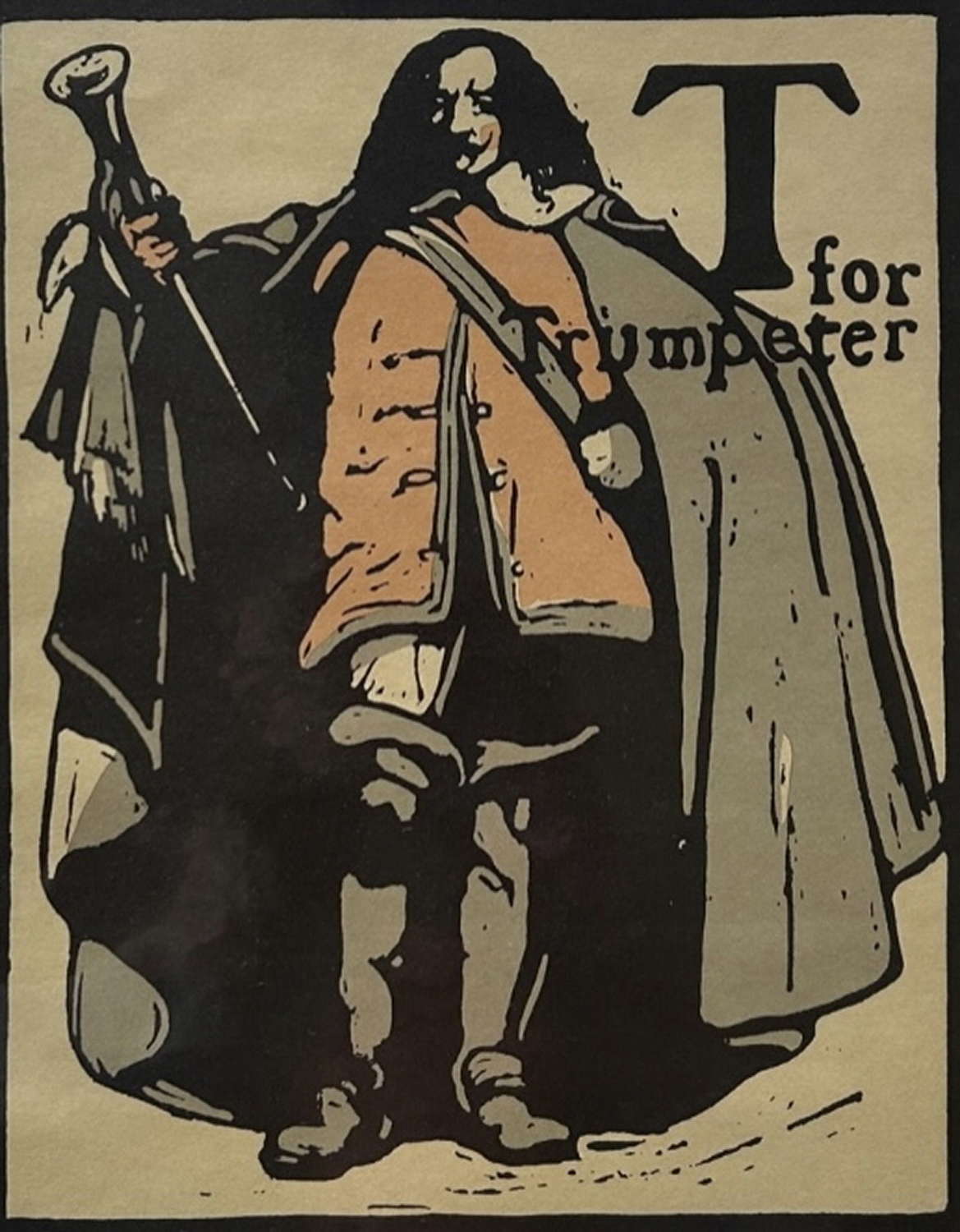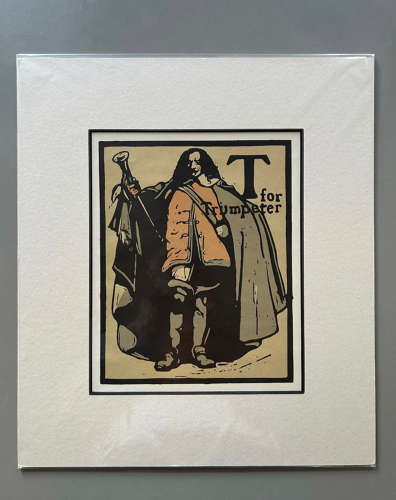

Lithograph entitled T for Trumpeter by William Nicholson
Code: 12535
Lithograph entitled T for Trumpeter by William Nicholson.
Dimensions:
Mount size: 41cms x 35.5cms
Image size: 24.7cms x 19.7cms
Condition : Near Fine
As our Photograph shows, our lithograph is double-mounted and protected by a polythene cover.
This lithograph is from William Nicholson’s Alphabet Series, which brought him success with the public and critics whilst he was still a young man. The prints, originally conceived as a tiny edition of hand-coloured woodcuts, were published by William Heinemann as lithographs in 1898.
Several of the figures are witty and ironic. For example, A was an artist is a self portrait of Nicholson as a pavement artist whilst B for Beggar shows his brother-in-law, James Pryde leaning on a staff.
Pryde and Nicholson were, at the time, working together under the pseudonym J & W Beggarstaff.
Lithograph edition by William Heinemann
They were produced in 1898 by William Heinemann and took following two forms:
i. Trade/popular edition
It was printed on cartridge paper, which generally turns brown with age and also offsets ink from facing pages.
ii. Library edition
It was printed on Japanese vellum and usually has a creamy colour.
Edition sizes of both editions are not known.
Additionally, there were US and French Versions. (All the copies for the US co-publisher, R H Russell were produced in London. R H Russell’s orders typically were 150-250.)
Date of Publication: 1898
Nicholson, William (1872 - 1949)
William Nicholson is widely admired for his work as a painter, printmaker and theatre designer. William Newzam Prior Nicholson was born on the 5th of February 1872 in Newark-on-Trent, Nottinghamshire. Nicholson’s talent for art was noticed early on, and from the age of twelve he enjoyed private drawing lessons from his school drawing master William Cubley. Nicholson left school at the age of 16 to study at Hubert Herkomer’s School of Art in Bushey; however Nicholson was not impressed by the dogmatic teaching there and by October 1891 he left England for Paris. Once there Nicholson studied at the Académie Julian and soon discovered the treasures of the Louvre. Nicholson decided to return home after several months and at some point between 1890 and 1892 he made his first woodcut. In April 1893 Nicholson married Mabel Pryde, who he had met at Herkomer’s, and together they moved to Denham, Buckinghamshire.Their first son, Ben went on to become the famous painter and sculptor.
In 1894 William Nicholson made his first poster design in partnership with his fellow artist, and brother-in-law, James Pryde. The two artists produced various poster designs under the pseudonym J. and W. Beggarstaff.
Over the next few years; these were greatly admired at the International Artistic Pictorial Poster Exhibitions held at the Westminster Aquarium in 1894 and 1896. Nicholson soon turned to the woodcut medium in earnest. In 1896, after seeing William’s woodcut of the Prince of Wales’s Derby-winning horse Persimmon at the Fine Art Society, Whistler recommended the young artist to his friend the publisher William Heinemann. This collaboration was to prove the turning point in Nicholson’s career as a printmaker and key series of ‘cuts’ including An Alphabet, An Almanac of Twelve Sports, London Types, and Twelve Portraits were published by Heinemann to great acclaim over the next few years.
After 1900, despite winning a gold medal for his woodcuts at the Exposition Universelle in Paris, Nicholson decided to make painting, rather than printmaking, his principal activity; he needed a break from engraving blocks and was finding it hard to support his growing family on what he earned. However Nicholson did return to printmaking at regular intervals over the following years, and it was printmaking that had made his early reputation.
As early as 1890 he began to make woodcuts and to experiment with the addition of subtle tints of green, ochre and amber to his black and white compositions. He soon became known for his skill and innovation in the
medium, elevating the art form, both aesthetically and commercially.
In 1897, Nicholson produced his celebrated portrait, Queen Victoria, which became one of the most famous British prints ever made. Originally there were four series of woodcuts entitled, Portraits, Almanac of
Twelve Sports, Alphabet and London Types.
Nicholson went on to have great success as a painter, particularly for his portraits and still-lives. In 1936 he was awarded a knighthood and Nicholson was given a retrospective exhibition of his work at the National Gallery in 1942.
He was appointed a Trustee of the Tate Gallery from 1934-39 and knighted in 1936.
William Nicholson died on the 16th of May 1949 at Blewbury in Berkshire.
